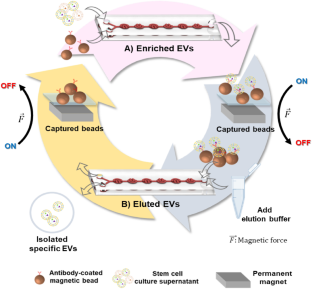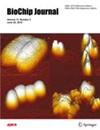Continuous Isolation of Stem-Cell-Derived Extracellular Vesicles (SC-EVs) by Recycled Magnetic Beads in Microfluidic Channels
IF 6.1
3区 工程技术
Q1 BIOCHEMICAL RESEARCH METHODS
引用次数: 0
Abstract
Stem cells produce nanosized particles known as extracellular vesicles (SC-EVs), which therapeutically affect stem cells. EVs are more abundantly produced, exhibit better stability, and possess lower immune rejection rates than stem cells. However, the traditional methods of isolating EVs, such as ultracentrifugation, possess limitations that require a complex process and consume more time. Moreover, it is difficult to isolate specific EVs that have target surface proteins that affect regenerative effects. To address these limitations, a new dual-mode horseshoe-shaped orifice micromixer (DM-HOMM) chip that can bind antibody-conjugated micromagnetic beads and SC-EVs and sequentially elute specific SC-EVs on the beads using an eluent was developed. For effective elution from the microbead-SC-EV complex, four types of eluents were used to control pH and ionic strength between antibodies and surface proteins in EVs. In addition, we investigated the reusability of antibody-conjugated micromagnetic beads. The beads indicated identical binding efficiencies between the antibodies and specific SC-EVs for three repeated cycles using the dual-mode chip. CD63+ EVs collected by the chip exhibited higher cell viability and regeneration effects than untreated and total EVs. This SC-EVs’ isolation method possesses the potential for targeted therapeutic applications and enhanced regenerative effects.

微流控通道中再生磁珠连续分离干细胞来源的细胞外囊泡(sc - ev
干细胞产生被称为细胞外囊泡(sc - ev)的纳米颗粒,其治疗作用于干细胞。与干细胞相比,电动汽车的产量更高,稳定性更好,免疫排异率更低。然而,传统的分离ev的方法,如超离心,有其局限性,需要一个复杂的过程和更长的时间。此外,很难分离出具有影响再生效果的靶表面蛋白的特异性电动汽车。为了解决这些限制,研究人员开发了一种新的双模式马蹄形孔微混合器(DM-HOMM)芯片,该芯片可以结合抗体偶联的微磁珠和sc - ev,并使用洗脱液顺序洗脱珠上的特异性sc - ev。为了有效地洗脱微珠- sc - ev复合物,使用了四种类型的洗脱液来控制ev中抗体和表面蛋白之间的pH和离子强度。此外,我们还研究了抗体偶联微磁珠的可重复使用性。在双模芯片的三个重复循环中,抗体和特定sc - ev之间的结合效率相同。芯片收集的CD63+电动汽车比未处理的和总电动汽车具有更高的细胞活力和再生效果。这种分离sc - ev的方法具有靶向治疗应用和增强再生效果的潜力。
本文章由计算机程序翻译,如有差异,请以英文原文为准。
求助全文
约1分钟内获得全文
求助全文
来源期刊

BioChip Journal
生物-生化研究方法
CiteScore
7.70
自引率
16.30%
发文量
47
审稿时长
6-12 weeks
期刊介绍:
BioChip Journal publishes original research and reviews in all areas of the biochip technology in the following disciplines, including protein chip, DNA chip, cell chip, lab-on-a-chip, bio-MEMS, biosensor, micro/nano mechanics, microfluidics, high-throughput screening technology, medical science, genomics, proteomics, bioinformatics, medical diagnostics, environmental monitoring and micro/nanotechnology. The Journal is committed to rapid peer review to ensure the publication of highest quality original research and timely news and review articles.
 求助内容:
求助内容: 应助结果提醒方式:
应助结果提醒方式:


